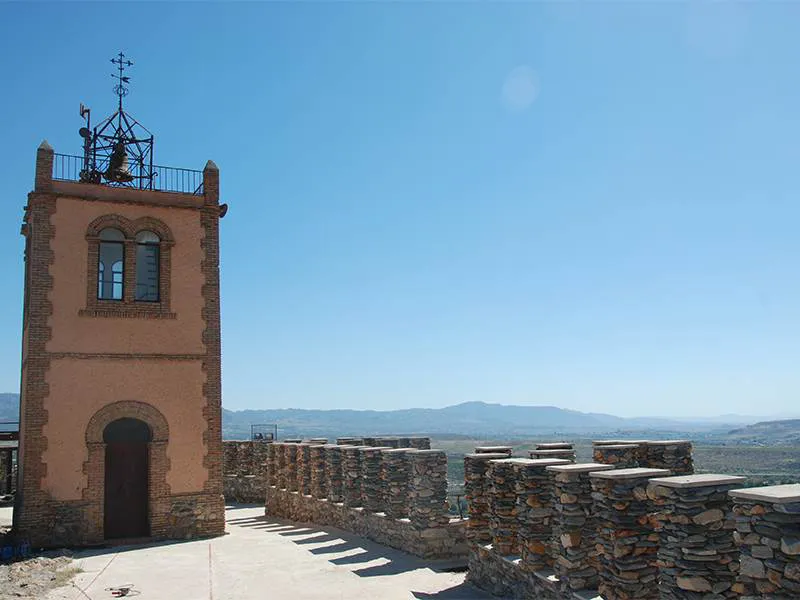Serón is a white village in in the foothills of the Sierra de los Filabres in Almeria province, Andalucia. Serón is famous for its jamón, chorizo and morcilla.
By Nick Nutter | Updated 22 May 2023 | Almería | Villages |
Login to add to YOUR Favourites or Read Later


Seron
Serón is one of those rare places where you can go for the day and find yourself staying a week. At an altitude of 800 metres, on the northern flank of the Sierra de los Filabres, the approaches to Serón are dominated by the town’s castle beneath which a cluster of white houses with orange tiled roofs cling to the rock buttress and spread out into the gentler lower slopes. The buildings are separated by a crazy network of narrow alleys, ramps and steps, typical of the Moorish era. Clearly the focal point of any visit to the town, the castle is a good place to start a tour.


Seron Castle
From the battlements the view is expansive; the entire Almanzora valley, the Sierra de las Estancias and a good portion of the province of Granada. The castle was built in the 13th century as part of a network of fortifications to defend the route from the Almanzora to Baza. Of the original build, only one wall and some foundations remain. Modifications through the ages culminated in a 21st century sympathetic restoration that gives a good idea of what the original castle looked like. The clock tower, in a Neomudéjar style, is a 20th century addition. In 1570, during the Morisco revolts, the Morisco inhabitants of Serón were besieged by the Christian forces commanded by Don Juan de Austria. It is said that he suffered his greatest defeat at Serón whilst unsuccessfully besieging the town. Although the town eventually surrendered in March 1570, Juan took his revenge and put large numbers of the surviving Moriscos to the sword. The massacre took place on a street next to the 17th century Iglesia Parroquial Nuestra Senora de la Anunciación. The street was originally named Calle de los Muertos. The name was later changed to Calle Don Juan de Austria.


View from Seron Castle
Just beneath the ancient castle is the very modern (opened May 2020), Centro de Historia de Serón. At the time of writing (June 2020) the centre is only open on Saturdays and Sundays. This small museum explains the history of Serón from prehistoric times to the modern day. Of particular interest is the late 19th early 20th century when mining companies from Britain, Belgium and the Netherlands arrived in the area and built an entire town near Serón, Las Menas, together with all the infrastructure, aerial runways to transport the iron ore to the railway at Serón, houses, a hospital, even a bullring and a football pitch.
The town itself is a typical white village, narrow streets, colourful flower planters and a central plaza with bars and restaurants. Not so typical are the two Jamón processing plants. Serón has a long history of producing succulent, air cured Jamón, chorizo and morcillas. Since 1995 the annual Feria del Jamón y de la Productos Cárnicos de Serón has drawn huge crowds on the first weekend in July. Sadly, due to the coronavirus, the festival will not be held in 2020.


Video By: Julie Evans


Muslim HIMS SHARUM
During the first weekend in August, the entire town participates in a colourful celebration, Las Jornados Medievales HIMS SHARUM. Moors and Christians once again take to the streets of Serón with music, dancing and the inevitable mediaeval market promoting local artisan products ranging from items made from esparto grass to ceramics and glass.


Calle Don Juan de Austria
For the more active visitor, the Sierra de los Filabres is on the doorstep. There are dozens of well marked trails through the Sierra. The highest peak is Calar Alto. At 2168 metres it is a prominent feature 10 kilometres south of Serón. As befits the highest peak in Almeria there is an observatory on the top that is normally open to the public by appointment. Climbers and cavers are well catered for and walkers and cyclists have the Via Verde of Iron, the old mineral railway line from which to appreciate the scenery in the Almanzora valley.
The Almanzora Tramo del Hierro Greenway Nature Trail is an old disused route of the Guadix-Almendricos railway that dates back to 1894. Along its 11.8 kilometre length you will find iron ore loading platforms. In its heyday a dense network of aerial cables brought the iron ore from the mines in the surrounding hills, down to the station at Serón. Some of the station buildings have been converted to a restaurant, an exhibition and concert hall and a bicycle rental business. You will also find the Centro de Interpretación Valle de Almanzora Aire.
This free exhibition not only provides information about the renewable energy resources in the area, primarily wind turbines, it also has lots of tourist information about the area, its gastronomy, places of interest, walking routes, culture, various activities and accommodation. It is also possible to book a trip to the Calar Alto observatory. Please ring 950426001 for opening times.